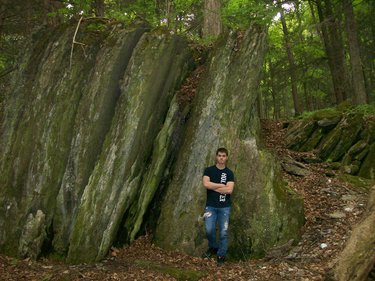Wild ramp season on the talus slopes
Geologists, I have often told my students, have a name for virtually everything. For most people, an expression such as “debris that collects at the base of a cliff” would be sufficient to describe debris that collects at the base of a cliff!
But geologists find such an expression rather cumbersome — many of them write astonishingly fine prose — and to avoid that wordy phrase they have coined the term “talus.” It is a generic term, for when cliffs are as high and massive and diverse in their layered rock types as our Helderberg escarpment is — some layers being soft and thin-bedded and easily weathered, others being extremely hard and massive — they will break down and produce fragments ranging in size from clay particles to gigantic, jumbled slabs.
Then under the force of gravity and the many agents of erosion—ice, water, and wind—they will begin their journeys to lower elevations on the slopes: journeys that may take moments or days or centuries.
The Helderberg escarpment rises from close to the level of the Hudson River near Ravena and then moves northward on a gradual tilt that lifts it a couple of hundred or so feet per mile, reaching its greatest elevation at High Point above Altamont, where it turns west and gradually diminishes.
Its most prominent cliff is made of two layers of hard limestone — the Lower Manlius and above it the Coeymans — but those layers sit on alternating beds of relatively soft sandstone and shale known as the Indian Ladder beds and are capped by the Kalkberg and the New Scotland limestones, and other beds of shale, sandstone, and limestone. All of these layers have been subjected to millennia of attack by the forces of nature, and the result is that the escarpment sits on a talus slope hundreds of feet high.
It is a hauntingly beautiful environment, radically different from the orchards and cornfields that border it. The haunt of crows, ravens, pilgrim thrushes, and (in spring) migrating white-throated sparrows, vast forests of deciduous trees and hemlocks on the slopes have had to grow to great heights in order to reach sunlight and have produced a world of perpetual green shade and trickling water.
Since the slopes also face north, whatever sunlight gets through the forest canopy never strikes the ground at a steep angle and the environment tends to be very humid. Humidity is conducive to weathering and so the bedrock layers are buried under dirt and gravel and larger rock fragments, providing an atmosphere like that of a terrarium, and with similar results.

Every surface is covered with plant life, from the top of small, flat rocks to the massive boulders that moved down the slopes long ago, probably under the influence of the last glacial ice that covered this area. These are plants that thrive in a wet environment with limited light: violets, trilliums, jack-in-the-pulpits, wild ginger, trout lily, Dutchman’s breeches, and a vast variety of ferns, among others.
They appear soon after the last snow is gone and bloom for a few days and then vanish for another year. But one in particular is sought after not for its exotic flower but for its odor and taste: the wild ramp, also known as spring onion, wild garlic, and by other names.
The leaves of wild ramps somewhat resemble those of the lily-of-the-valley, but to the alert eye they signal the presence of a wild onion with a sharp taste that is both sweet and spicy; its odor and flavor can make something very special of an otherwise commonplace dish.
Once their shiny leaves appear, it is a matter of just a couple of weeks before the bulbs swell to half an inch or more in diameter. Then, as they are dug from the ground, their zesty onion odor permeates the air.

Washed and with their roots cut away, the ramps may be used as flavoring in dozens of dishes; they may be boiled or roasted, or they may simply be eaten raw, giving the tang of spring to salads or plates of raw vegetables. After a few more short weeks, the leaves wither — among the first of all forest plants to turn yellow as the season progresses — and vanish until the next year’s spring melt and first warm days awaken them again.
An Internet search for “wild ramps” yields upward of 60,000 sites; one quickly learns that wild ramp festivals are held in many Appalachian sites in the spring. And many of the websites deal with the folklore associated with the plants.
Medieval and early American populations believed the plant to have medicinal qualities — but, of course, onions have long been known to be good for digestion and for the heart. Probably the more outrageous claims of the ramp’s health-giving qualities are myths, but one can easily understand why the stories have arisen.
For following a cold, snowy, barren winter such as the one we just experienced, suddenly the newly greening forest features a modest-looking plant, which — when drawn from the ground — yields a fragrance as fresh and as invigorating as spring itself.
And what better way to experience the return of the warmer weather than to take a stroll through the forests of the Helderberg talus slopes to enjoy the greenery, perhaps catching a glimpse of the 42 shades of green that it is said every Irishman can distinguish; to listen to the music of the newly-arrived birds and the trickling of the last snow melt; and amid the exhilarating smells of the woods to be fortunate enough to catch the tang of the wild ramp.
